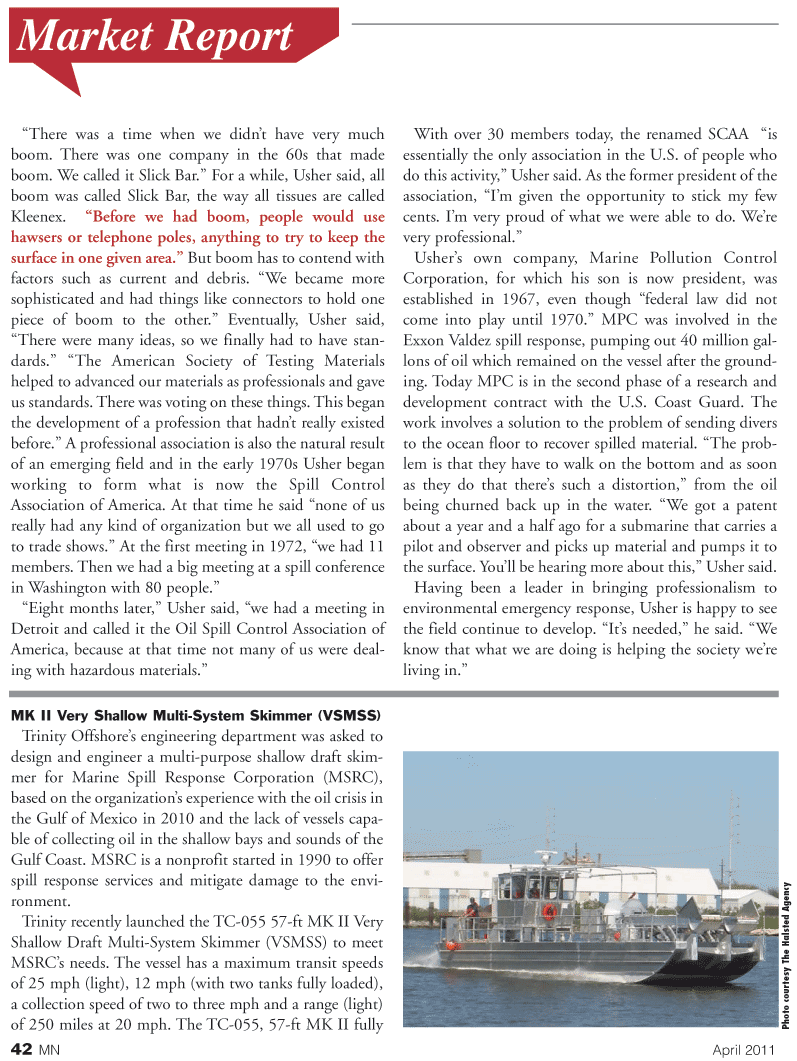
Page 42: of Marine News Magazine (April 2011)
Offshore Energy Edition
Read this page in Pdf, Flash or Html5 edition of April 2011 Marine News Magazine
MK II Very Shallow Multi-System Skimmer (VSMSS)
Trinity Offshore’s engineering department was asked to design and engineer a multi-purpose shallow draft skim- mer for Marine Spill Response Corporation (MSRC), based on the organization’s experience with the oil crisis in the Gulf of Mexico in 2010 and the lack of vessels capa- ble of collecting oil in the shallow bays and sounds of the
Gulf Coast. MSRC is a nonprofit started in 1990 to offer spill response services and mitigate damage to the envi- ronment.
Trinity recently launched the TC-055 57-ft MK II Very
Shallow Draft Multi-System Skimmer (VSMSS) to meet
MSRC’s needs. The vessel has a maximum transit speeds of 25 mph (light), 12 mph (with two tanks fully loaded), a collection speed of two to three mph and a range (light) of 250 miles at 20 mph. The TC-055, 57-ft MK II fully 42 MN April 2011 “There was a time when we didn’t have very much boom. There was one company in the 60s that made boom. We called it Slick Bar.” For a while, Usher said, all boom was called Slick Bar, the way all tissues are called
Kleenex. “Before we had boom, people would use hawsers or telephone poles, anything to try to keep the surface in one given area.” But boom has to contend with factors such as current and debris. “We became more sophisticated and had things like connectors to hold one piece of boom to the other.” Eventually, Usher said, “There were many ideas, so we finally had to have stan- dards.” “The American Society of Testing Materials helped to advanced our materials as professionals and gave us standards. There was voting on these things. This began the development of a profession that hadn’t really existed before.” A professional association is also the natural result of an emerging field and in the early 1970s Usher began working to form what is now the Spill Control
Association of America. At that time he said “none of us really had any kind of organization but we all used to go to trade shows.” At the first meeting in 1972, “we had 11 members. Then we had a big meeting at a spill conference in Washington with 80 people.” “Eight months later,” Usher said, “we had a meeting in
Detroit and called it the Oil Spill Control Association of
America, because at that time not many of us were deal- ing with hazardous materials.”
With over 30 members today, the renamed SCAA “is essentially the only association in the U.S. of people who do this activity,” Usher said. As the former president of the association, “I’m given the opportunity to stick my few cents. I’m very proud of what we were able to do. We’re very professional.”
Usher’s own company, Marine Pollution Control
Corporation, for which his son is now president, was established in 1967, even though “federal law did not come into play until 1970.” MPC was involved in the
Exxon Valdez spill response, pumping out 40 million gal- lons of oil which remained on the vessel after the ground- ing. Today MPC is in the second phase of a research and development contract with the U.S. Coast Guard. The work involves a solution to the problem of sending divers to the ocean floor to recover spilled material. “The prob- lem is that they have to walk on the bottom and as soon as they do that there’s such a distortion,” from the oil being churned back up in the water. “We got a patent about a year and a half ago for a submarine that carries a pilot and observer and picks up material and pumps it to the surface. You’ll be hearing more about this,” Usher said.
Having been a leader in bringing professionalism to environmental emergency response, Usher is happy to see the field continue to develop. “It’s needed,” he said. “We know that what we are doing is helping the society we’re living in.”
Market Report
Photo courtesy The Halsted Agency

 41
41

 43
43
